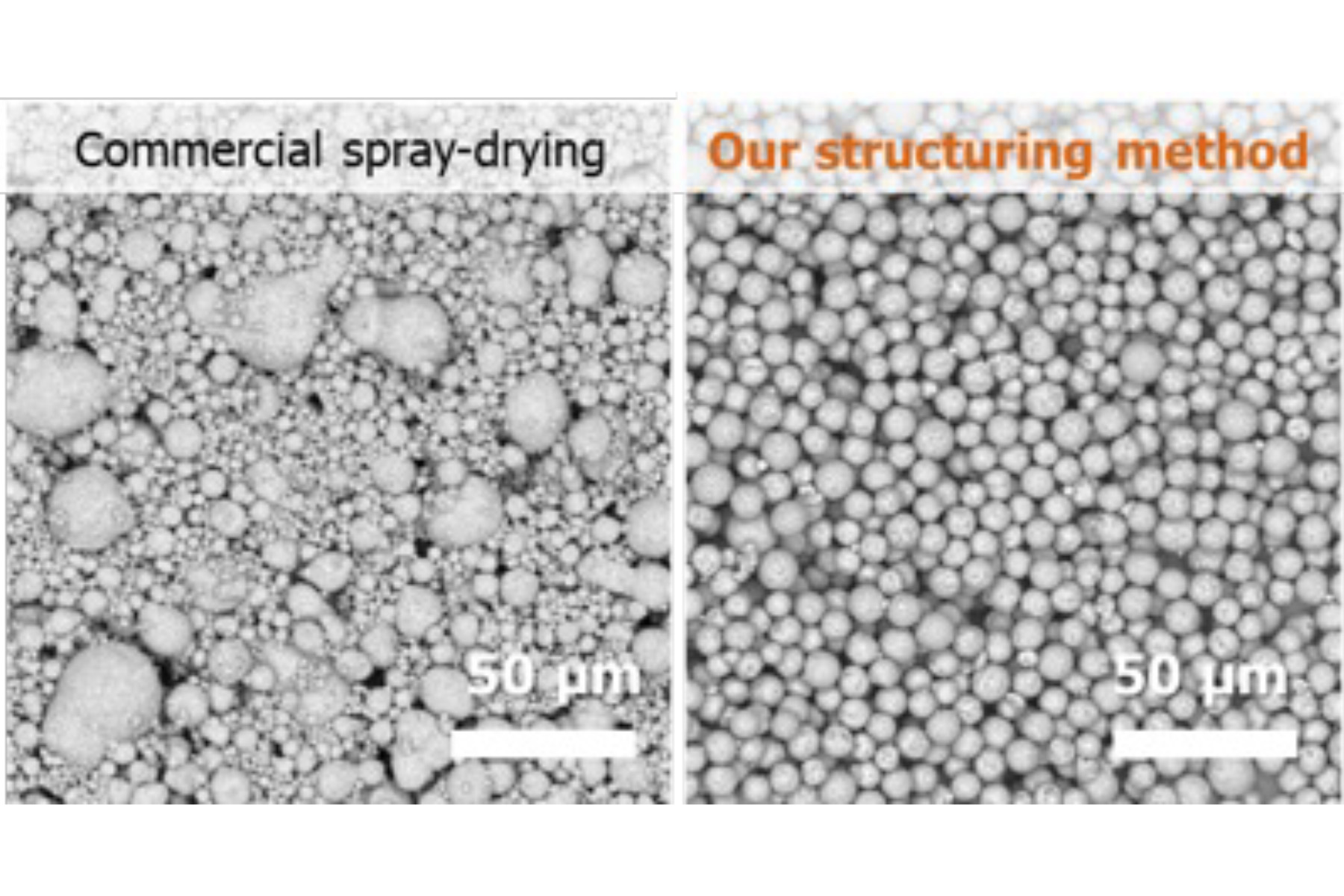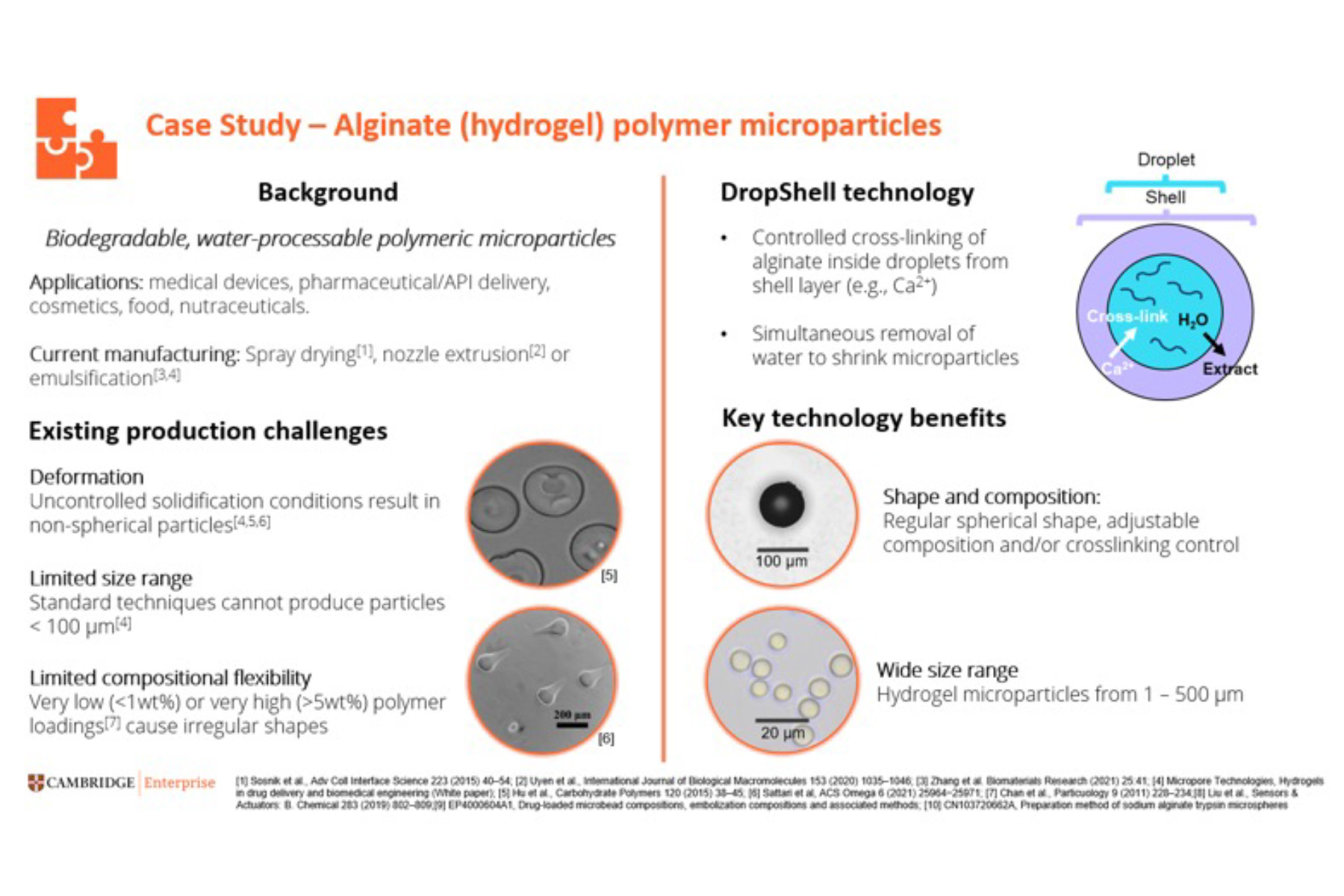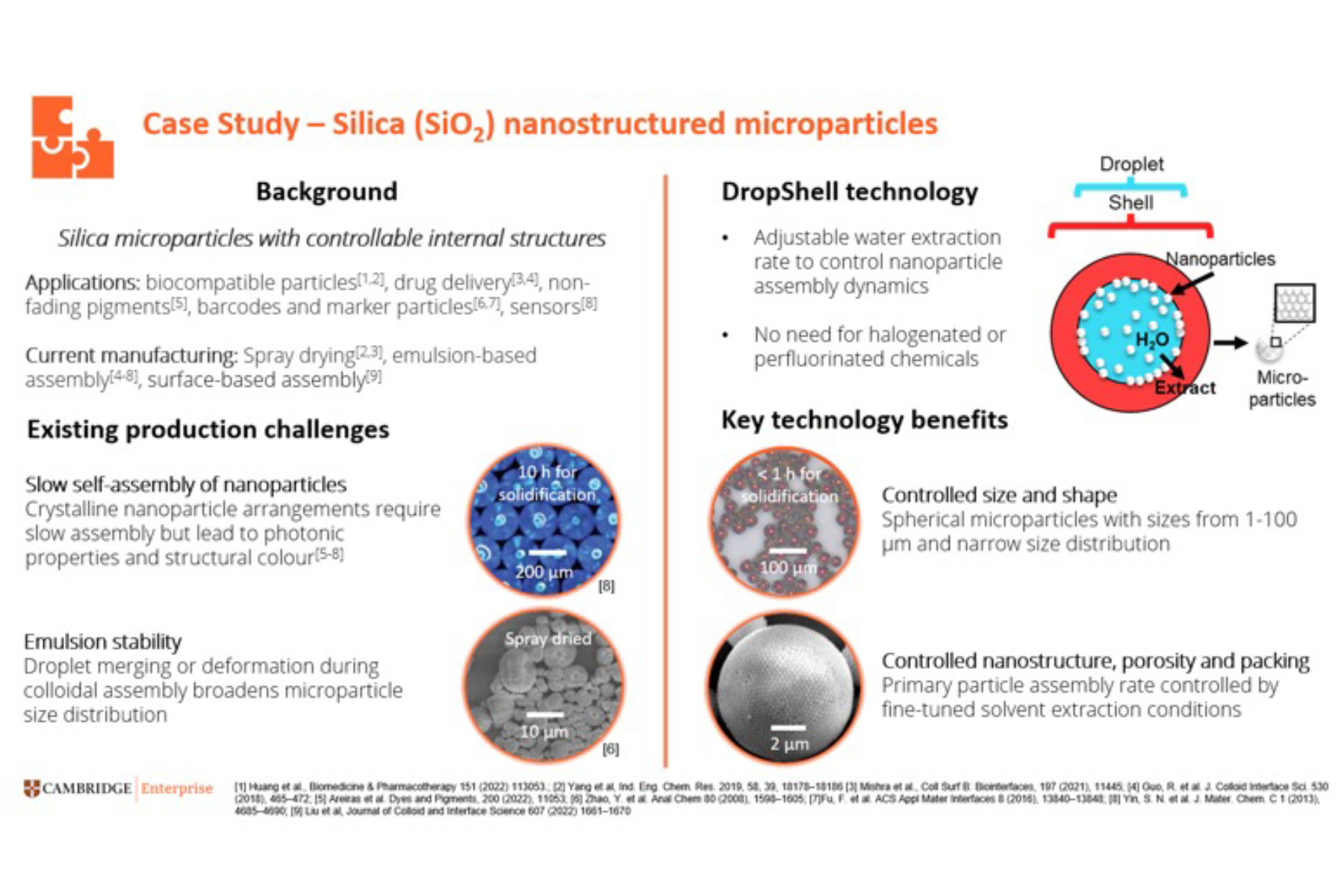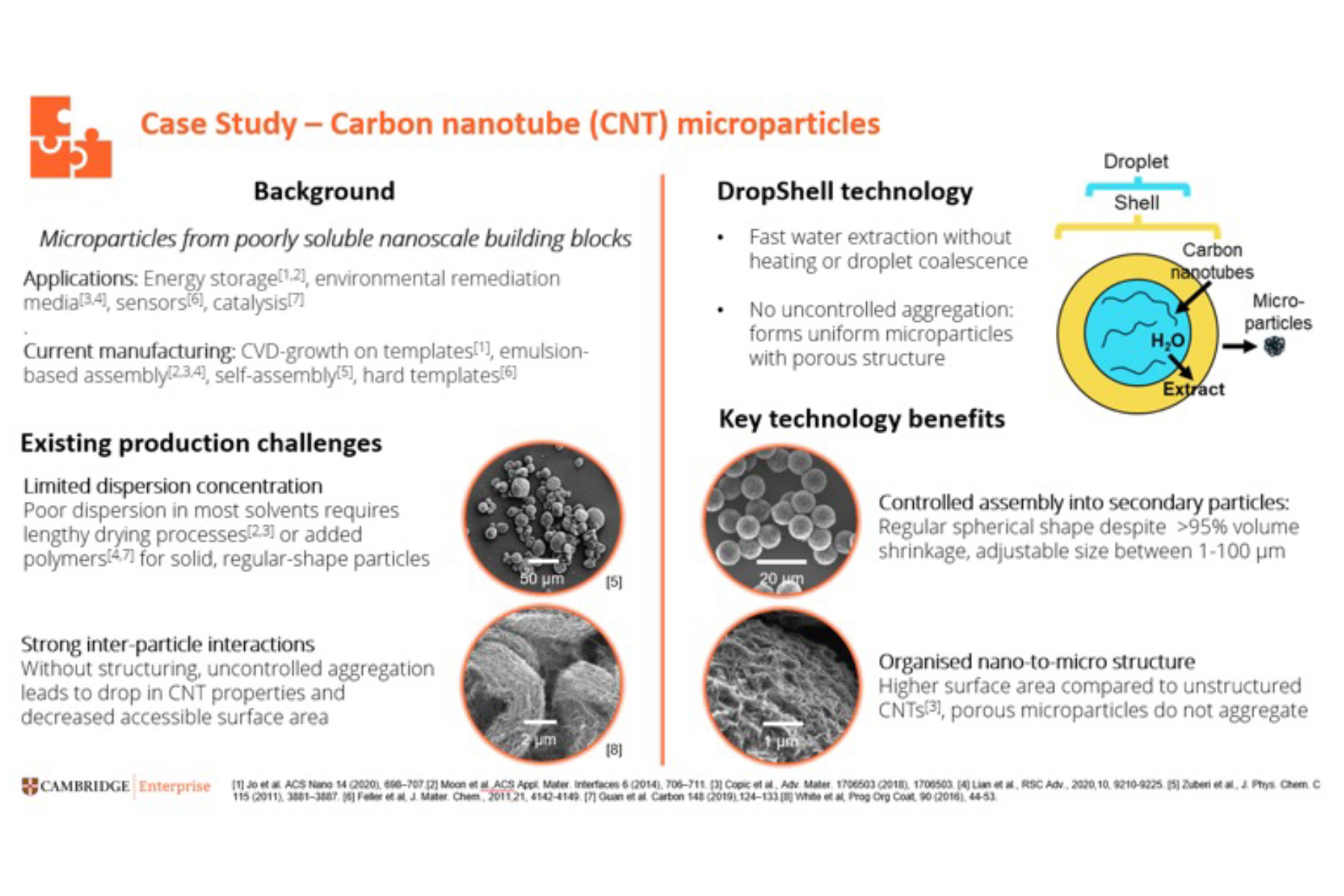Controlled microparticle processing technology.
Engineered microparticles are ubiquitous in many commercial products, from agritech to nutraceuticals and cosmetics.
In the pharmaceutical industry, controlled encapsulation and delivery of therapeutic substances in identical, micro-scale particles can demonstrably improve treatment efficacy, and decrease patient non-compliance. A significant hurdle is achieving precise microparticle uniformity, a challenge that becomes increasingly complex when considering the necessity for micro-scale control during processing alongside mass production. Existing state-of-the-art processes for microparticle production (such as spray-drying) fail to achieve sufficient uniformity, requiring extensive sorting which results in material losses, including costly active ingredients. Therefore, cost-effective production of these delivery systems is a significant market obstacle.
As a result, controlled emulsification techniques (such as microfluidics/membrane emulsification) are being increasingly adopted industrially, which enable microparticle formation from droplet templates. These techniques generate droplets with precisely controlled sizes unlike conventional techniques e.g. spray-drying. However, current commercial solutions are restricted to select material categories (e.g. cannot handle aqueous materials), tend to be costly or environmentally harmful (e.g. perfluorinated oil/surfactant blends) and have limiting options for downstream processing of droplets into microparticles (solidification, drying, cross-linking).
The inventors of the process described here developed an emulsion formulation and processing method that provides extremely high stability and localised control over individual droplets during processing. The method enables formation of ultra-stable aqueous droplet templates, and allows for controlled chemical/solvent transport to solidify microparticles, maintaining an extremely narrow size distribution (~10% variation) and near-100% yield in the final product.
Technology overview
Our technology is a platform emulsion formulation and processing method for precision microparticle production. When combined with controlled emulsification hardware tools (such as microfluidics/membrane emulsification), our method enables the rapid and low-cost manufacture of microparticles with adjustable size, regular shapes, and extremely narrow size distributions.
The technology has two exceptional features:
- The emulsion is extremely stable, so droplets maintain their size and size distribution;
- Local controlled mass transport can be performed to- and from- droplet templates to solidify them into microparticles (e.g. by drying, precipitation, cross-linking).
The formulation therefore allows droplet templates to maintain their desirable properties all the way from emulsification to microparticle solidification, alleviating the need for further downstream sorting and material loss. Importantly, this is a broadly compatible platform process to create microparticles from water-processible materials including polymers, inorganic materials and nanoparticles.
Benefits
- Regular, spherical microparticles with sizes from ~1-500 µm
- Improved microparticle size distribution compared to spray drying or top-down structuring methods
- Near-100% yield when combined with controlled emulsification tools
- Drop-in formulation not sensitive to emulsification method: proven with microfluidics, membrane emulsification, bulk emulsification.
- Enhanced emulsion stability during processing
- No perfluorinated oils or surfactants
- Mild, room temperature processing conditions
- Controlled, uniform microparticle solidification in closed system e.g. flow or batch processing
- Compatible with water-processable materials e.g. polymers, silica, inorganic nanoparticles, hydrophilic ingredients
Applications
- Manufacturing of size-controlled, uniform microparticles for encapsulation and delivery of APIs
- Production of small (<10 µm) hydrogel microparticles through combined solvent extraction and cross-linking (e.g. alginate)
- Production of well-defined structured microparticles requiring precision assembly (e.g. assembled silica nanoparticle with controlled crystallinity/porosity)
- Alternative to spray-drying – our method is suitable for solution processing of problematic materials (e.g. slow-drying, thermally unstable, poorly soluble substances)
- The technology is of particular interest to users of controlled emulsification tools who are looking for a cost-effective, stable and versatile formulation solution for microparticle production, which is not material specific.
Opportunity
- We are seeking industrial collaboration or co-development partners to help to commercialise the technology under license.
Founders
Dr Kate Sanders
Kate is a postdoctoral researcher working in the Engineering Department. Previously she was an EPSRC NanoDTC Translational Prize fellow, and has also been awarded a CAPE Acorn Blue Sky award and EPSRC IAA Early-stage Commercialisation award on the development of scalable microparticle processing methods. She received her PhD from the University of Cambridge on the controlled production of microparticles from nanoparticles using emulsions.
Dr Ryo Mizuta
Ryo is a postdoctoral researcher working in the Engineering Department. Prior to this, he was an EPSRC NanoDTC Translational Prize research fellow in the Bioelectronics Lab (Prof. George Malliaras), working on the commercialisation of wearable biosensors for vaginal health monitoring. He completed his PhD in 2021 at the University of Cambridge.
Prof Michaël De Volder
Michaël is a Professor at the Institute for Manufacturing at the University of Cambridge, leading the Nanomanufacturing group. His research interests focus on the development of scalable technologies to structure advanced materials into multiscale structures for applications including energy storage, sensors, and water purification. Michael was previously awarded a ERC-Consolidator and UKRI guarantee-funded ERC PoC grant with a focus on droplet-based structuring processes. Additionally, he has previously co-founded two successful UK spin-outs (Echion Technologies, Myriofoam).
References & Patents
UK Patent Office Application 2401516.6.
Enquiry for Microparticle production platform technology (DropShell)
Tags: droplets, emulsion, monodisperse, particles, spheres, water droplet








